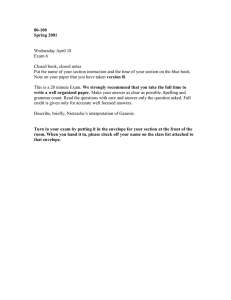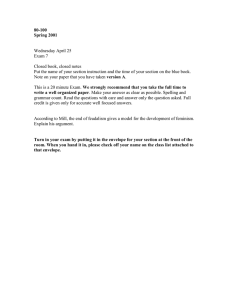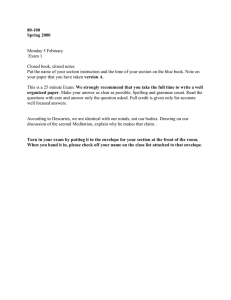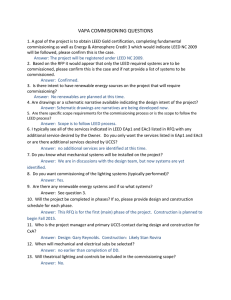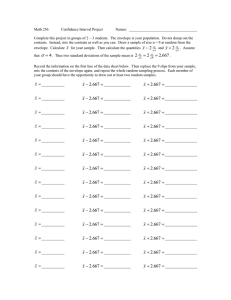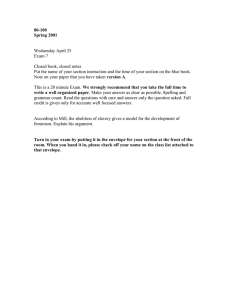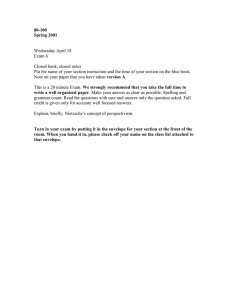The Need for Enhanced Commissioning
advertisement
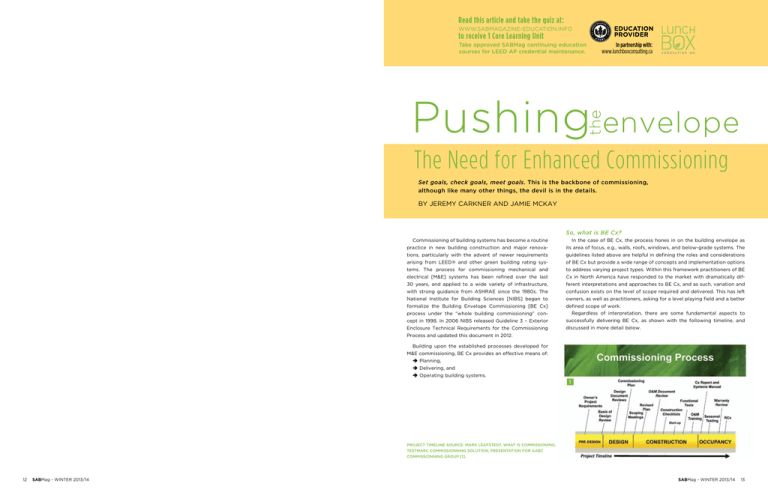
Read this article and take the quiz at: WWW.SABMAGAZINE-EDUCATION.INFO to receive 1 Core Learning Unit Take approved SABMag continuing education courses for LEED AP credential maintenance. In partnership with: www.lunchboxconsulting.ca the Pushing envelope The Need for Enhanced Commissioning Set goals, check goals, meet goals. This is the backbone of commissioning, although like many other things, the devil is in the details. BY Jeremy Carkner and Jamie McKay So, what is BE Cx? Commissioning of building systems has become a routine In the case of BE Cx, the process hones in on the building envelope as practice in new building construction and major renova- its area of focus, e.g., walls, roofs, windows, and below-grade systems. The tions, particularly with the advent of newer requirements guidelines listed above are helpful in defining the roles and considerations arising from LEED® and other green building rating sys- of BE Cx but provide a wide range of concepts and implementation options tems. The process for commissioning mechanical and to address varying project types. Within this framework practitioners of BE electrical [M&E] systems has been refined over the last Cx in North America have responded to the market with dramatically dif- 30 years, and applied to a wide variety of infrastructure, ferent interpretations and approaches to BE Cx, and as such, variation and with strong guidance from ASHRAE since the 1980s. The confusion exists on the level of scope required and delivered. This has left National Institute for Building Sciences [NIBS] began to owners, as well as practitioners, asking for a level playing field and a better formalize the Building Envelope Commissioning [BE Cx] defined scope of work. process under the “whole building commissioning” con- Regardless of interpretation, there are some fundamental aspects to cept in 1998. In 2006 NIBS released Guideline 3 – Exterior successfully delivering BE Cx, as shown with the following timeline, and Enclosure Technical Requirements for the Commissioning discussed in more detail below. Process and updated this document in 2012. Building upon the established processes developed for M&E commissioning, BE Cx provides an effective means of: â Planning, â Delivering, and â Operating building systems. 1 project timeline source: Mark leafstedt, what is commissioning, testmarc commissionning solution, presentation for aabc commissionning group [1]. 12 sabMag - winter 2013/14 sabMag - winter 2013/14 13 BE Cx “In Practice” CASE STUDY: Collaborative Life Sciences Building, Owner’s Project Requirements Role of IDP The BE Cx Authority [BE CxA] acts as the Owner’s advo- Although BE Cx focuses primarily on building envelope systems, the pro- cate throughout all stages of the building’s design and con- cess follows a distinct and defined track in the design and construction pro- struction, and is a key resource in identifying and address- cess. Incorporating the BE CxA in an IDP allows a multitude of perspectives, ing performance issues during the first year of occupancy. priorities, specialties, and experts to discuss and arrive at whole building Owner’s Project Requirements [OPRs] are a critical task solutions. The BE CxA’s engagement during pre-design is helpful in these in establishing performance goals and expectations and instances since a greater degree of owner understanding and perspective ideally are developed during the pre-design stage. OPRs has been collected, thus solidifying the BE CxA’s position as an independent establish performance and functional requirements for the advisor all throughout the process. Unfortunately, the current trend in the passive building envelope systems, and allow design activi- industry is to engage the services of a BE CxA into design development or ties, material selections, and construction sequencing the later in design, and hence the early goal setting and independent advocacy opportunity to respond against an understood baseline. for the building envelope systems is more difficult to achieve. Oregon State University System/Oregon Health & Science University Collaborative Life Sciences Building, Oregon State University System/Oregon Health & Science University. Image courtesy of CO Architects and SERA Architects [2]. Size 650,000 ft2 Project Value $211 M [USD] Scheduled Completion 2014 Target LEED Platinum NC General Contractor JE Dunn 2 Building envelope systems are typically multi-layered, multi-component systems that require the installation of components in an overlapping sequence; which in many instances conceal the underlying layers. For this reason, it is imperative that effective and targeted design reviews, shop “The Plan” drawing reviews and construction mock-ups/site [manu- While most project teams are familiar with a M&E Cx plan and Cx specifi- facturing plant] reviews be undertaken. The importance of cations, the BE Cx plan and associated specifications are equally important early integration and review cannot be stressed enough – and must be integrated into the overall Whole Building Cx plan. The BE Cx without a properly designed assembly, no quantity of test- plan is intended to outline primary roles and responsibilities as well as the ing can make the system meet its initial goals. general process and timeline for BE Cx. The plan is contractually implemented via BE Cx specifications where the following typical requirements are outlined: â Shop drawing submittals and review process; â BE Cx Forms and Checklists for completion by the Constructor’s BE Cx Agent; â Material sample submittals; â Pre-installation meetings; Similarly to M&E OPRs, the BE Cx OPRs can be devel- â Installation forms and checklists; oped by the owner in isolation, however the involvement â Mandatory mock-ups; of a BE CxA in OPR development will enable the owner to â Mandatory manufacturers’ site visits, testing and reporting; evaluate their priorities and requirements. Unfortunately, â Sample removals and replacements; not all owners are equipped to develop a thorough and â Independent testing requirements and functional performance balanced OPR; considering the cost, time, and quality triangle, plus the principles of building science. A knowl- â Seasonal/post-occupancy functional testing checklists; and edgeable BE CxA can also help integrate the project’s sustainability initiatives into the OPR, including: daylighting strategies, passive energy optimization, service life determination and building durability planning. Design Review and System Execution Material selection, compatibility, constructability, and system continuity are each important elements to address during design reviews, particularly as the design phases progress into increasing levels of completion. Independent design reviews are best implemented with coordination and continued dialogue and feedback from the designers of record, such that issues or gaps are eliminated prior to the tendering stage. To add to the complexity, component materials have evolved over time requiring an increased level of knowledge of fundamental building science principles. This requires a consistent and robust process to evaluate operational performance of the passive building systems [envelope], which BE Cx affords via its focus on OPRs and design What is “included”? reviews as critical steps prior to construction. Once key goals are identified within the OPRs and the BE Cx plan and As construction begins, the Constructor’s BE Cx Agent specifications have been established, the task must begin to define the needs to organize and implement the required BE Cx activi- This being said, OPRs are inherently a dynamic set of building envelope and establish the performance characteristics for the ties and coordinate sub-trades and testing agencies. The parameters that can evolve and respond to design options various components and systems in terms of function[s], construction trade interaction between the BE Cx Agent [retained by con- and construction considerations. OPRs will also be tested involvement and overall responsibility [e.g., cross-over work]. Performance structor] and BE CxA [retained by owner] is such that BE during the Integrated Design Process [IDP] and this is an of the building envelope should be evaluated on the following functions Cx tasks and requirements are executed as defined and on opportunity for the BE CxA to demonstrate their role and [from Canadian Building Digest document #48 – Requirements for Exterior schedule, while overseen to minimize gaps in delivery and value to the full team, where their experience in a wide Walls, originally published in December 1963]: functional performance. • BE CxA Role: To provide technical feedback, review and keep the ownership group informed whether the design meets the OPRs. • Key BE CxA Activities: Review shop drawings and submittals; mock-up review/testing; fabrication shop visits; periodic field reviews during installation. • Timing/Coordination: OPRs written by architect in CD phase; BE CxA engaged late in CD phase. • Key Challenges: BE CxA vs. BE Consulting role definition; technical solutions and specific details; value-engineering process and compliance with OPRs; revisions to OPRs during CD phase. • Lessons Learned: Earlier involvement of BE CxA is warranted; clear definitions of roles and responsibilities; linkage of OPRs and consequences for end-users if OPRs compromised; documentation plan and buy-in by owner team; owner budget for BE Cx activities must be balanced against key expectations and areas to provide value to project team. Conclusion Using the framework outlined above, the BE Cx approach can be tailored to suit the specific needs for each project, owner and project team members. While the aim of industry may be to “push the envelope” with new systems, design configurations, and enclosures, the primary desires of high-performance, efficient buildings and long-term durability must remain. variety of building envelope systems and also under- â Heat flow control; standing of building envelope failure mechanisms can be â Air flow control; tify and document that the correct materials have been brought to bear as a means of evaluating trade-offs and â Water vapour flow control; installed, in the correct sequence and in accordance with changes in OPR philosophy. Functional characteristics for â Rain penetration control; the applicable design details. The performance verification building envelope systems must be used as the starting â Control of light, solar and other radiation; phase will then effectively “test” the in-situ elements to point for BE Cx OPR development, with a dedicated focus â Noise control; confirm the installation and identify any deficiencies. on energy [i.e. heat and air flow] and durability since these â Fire control; are essential considerations for a high-performance build- â Provision of strength and rigidity; provides a record of the installed materials, and mock- ing. These characteristics also influence the M&E OPRs â Durability; ups and tests completed. The report is a valuable piece and M&E system functional performance, and as such, BE â Aesthetics; and of information for diagnosing and addressing any post- Jeremy Carkner, P.Eng., LEED AP BD+C and Jamie McKay, P.Eng., LEED AP Cx and M&E Cx OPRs must be well-coordinated. â Economics construction issues that might arise. BD+C are with Morrison Hershfield Ltd., www.morrisonhershfield.com. 14 sabMag - winter 2013/14 The material and installation verification phase will iden- At the completion of the project, the BE Cx Final Report It is against this mandate that the BE Cx process functions most effectively. Although there are many possible paths to commission the building envelope, the emphasis should be placed on well-developed OPRs, early design review and an integrated commissioning plan. Understanding and communicating owner goals and intentions enables the team [design and construction] to align commissioning activities with project timelines and assign responsibilities, ultimately dispelling scope confusion while achieving lasting value. sabMag - winter 2013/14 15

